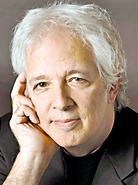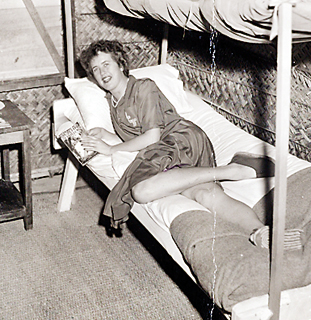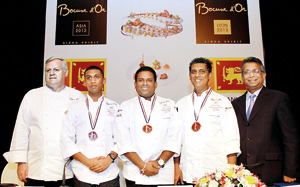Julia Child’s ‘secret’ life in World War II Ceylon
When Julia Child was dubbed ‘Our Lady of the Ladle’ in a Time Magazine cover story in 1966, she was already well on her way to becoming a towering figure (both literally and figuratively) in American public life.
A one-woman cultural revolution, Julia penned well over a dozen cookbooks (starting with the now iconic ‘Mastering the Art of French Cooking’) and became one of television’s greatest celebrities with a series of shows, the first of which was ‘The French Chef’ in 1963.

Bob Spitz
‘Hello, I’m Julia Child,’ she would say, pouring herself glasses of wine while turning out impeccable French sauces, massaging poultry into submission or warbling her way through a demonstration of how to make the perfect omelette. She threw out the T.V dinners and brought traditional cooking back into fashion – demystifying Cordon Bleu techniques and proving by exuberant example that there was joy and adventure to be found right there at your stove.
By the time Meryl Streep starred in the film ‘Julie & Julia’ in 2009, the real Julia was no longer around, having passed away at the age of 92. August 15, 2012 marks her 100th birth anniversary as well as the launch of a wonderful, comprehensive new biography: ‘Dearie: The Remarkable Life of Julia Child’.
In its early chapters, author Bob Spitz introduces us to a Julia who was such a bad cook that her family worried she might burn water, who was yet to meet Paul Child and who found herself in the company of the “Kandy kids” as a ‘keeper of secrets’ for the Office of Strategic Services (OSS) in Ceylon during World War II.
“Julia’s experience in Ceylon changed everything for her,” Bob told the Sunday Times in an email interview. “Before she arrived, she was aimless in life, looking — searching — for anything that would give her something meaningful to do. Her job in Ceylon, with the OSS, brought everything into focus for her. It taught her discipline and gave her purpose and responsibility. It is also where she met Paul Child, who would become her husband and lifelong mentor, the man who would fill up her “empty tank”. Going to Ceylon also made Julia appreciate foreign travel and learning about other cultures, which she enjoyed for the rest of her life.”
Julia would later describe her time in the OSS as “my growing-up period.” Though she initially docked in Bombay, she was soon transferred to Kandy where Lord Mountbatten, who oversaw the South East Asia Command (SEAC), had decided to relocate his headquarters. As the head of the Registry, Julia McWilliams had a high level of security clearance including access to the names of agents, student recruits, their various code names and the details of their missions. “Julia McWilliams was keeper of the secrets,” according to one operative; ‘As head of the Registry, she was privy to the most sensitive intelligence – and in charge of who else got to see it,’ writes Bob.

Though she worked hard – sometimes through the night and on Sundays as well – Kandy itself felt like paradise. Julia thought the town was like “like Shangri-La,” something right out of a fairytale. In a lovely passage in the book, Bob describes it through her eyes: ‘Monkeys played in the branches above the roofs, while “monks in bright saffron robes and shaved heads” threaded through the narrow weave of streets. The almost intoxicating spicy-sweet nectar of cinnamon blossoms filled the air. At more than 1,700 feet above sea level, the air was thinner and drier than on the coast, a condition Julia luxuriated in as being “skin-warm,” perfect to the touch. Mountbatten considered Kandy “probably the most beautiful spot in the world,” and from where Julia stood she would have had to agree with him.’
Housed in a colonial estate on a tea plantation with its own artificial lake, Mountbatten’s headquarters became a byword for elegance and luxury according to eyewitnesses. One man described it as “a place where well-groomed staff, many of them titled, were chauffeured in shiny limousines to offices scattered throughout the lush tropical gardens.” Despite the undoubted beauty of her surroundings, Julia herself struggled with boredom. She saw her job as “menial” and being the head of the Registry as nothing more than a euphemism for “running the files.”
To relieve the tedium, she played elaborate pranks. She penned ‘official’ memos to department heads that would announce a new filing system in which all documents were classified under the first letter of their last word or issued directives warning recipients that when the files were full they would be sealed forever, in a vault. Infuriated by the never ending bureaucratic red tape, she wrote to a colleague in the States: “If you don’t send Registry that report we need, I shall fill the next Washington pouch with itching powder and virulent bacteriological diseases, and change all the numbers, as well as translating the material into Singhalese [sic], and destroying the English version.”
Fortunately, someone would soon come along to give Julia something else to think about. “Before Julia met Paul, she was what he called “an empty vessel” — a rather pampered young woman, not a big thinker and rather unsophisticated,” Bob writes. “Paul had everything she lacked — and wanted.” Unfortunately, Paul Child did not make a good first impression. He was old, balding and short – “not all nice looking”, with “an unbecoming blond moustache and a long, unbecoming nose,” according to Julia. Her lack of regard was more than reciprocated, that was until a visit to ancient cave temples at Dambulla. There confronted with the ‘lavish display of artistry, a riot of murals and statues’ Julia responded with a ‘breathy chorus of astonishment and bluntness,’ and with that display of uninhibited enthusiasm, she first managed to attract Paul.
It was the beginning of a somewhat nebulous courtship, but one that culminated in the most significant relationship in her life. “For the next several years he [Paul] dedicated himself to shaping her life, encouraging her to read important, intellectual books, studying art, learning about politics and especially eating!” says Bob. “Before she met Paul, Julia’s palate was pretty bland. But he had been a world traveller all his life and he introduced her to that world and gave it meaning. He also encouraged her to learn how to cook and to pursue her dreams as a culinary guru.” Though little mention is made of what Julia and Paul thought of the island’s cuisine, Bob says she adored it. Their favourite early dates were the nights they spent hopping between local restaurants and Julia delighted in flavours of Southeast Asian cooking. “Together, they set out to devour the world, and I think they pretty much accomplished their goal,” says Bob.

This book owes its inspiration to several weeks Bob spent crisscrossing Sicily with Julia in 1992. ‘She was already a beloved icon, larger than life in so many different ways, but perhaps the most down-to-earth celebrity I’d ever encountered,’ he recalls. ‘She was exactly like her TV persona: warm, funny, outgoing, whip-smart, incorrigible, and, most of all, real.’
A long time musician, who had managed the likes of Bruce Springsteen and Elton John, Bob quit the music business in 1980 to pursue his love of writing and journalism.
Though he and Julia discussed working on a biography, another book – a definitive biography of the Beatles – delayed their collaboration. Bob managed to return to the project only after her death, spending four years poring over the vast archives at Harvard University (which included Paul’s journals and letters) and speaking with those who knew her well.
“For Americans, Julia Child changed the way we ate — and lived,” says Bob, reflectively. “Hers was a great American story that reads like an adventure — from her experiences in Ceylon at the height of World War II to post-war France, where she studied cooking, to an emerging American culture that she helped to shape and form.” For a biographer, Julia presents a challenge – courageous and irrepressible, here was a woman who reimagined herself in middle age and seemed to thrive under the weight of her staggering celebrity. For Bob’s readers, Julia’s extraordinary story is as appealing as the delicious food she served up to a nation.
comments powered by Disqus






















